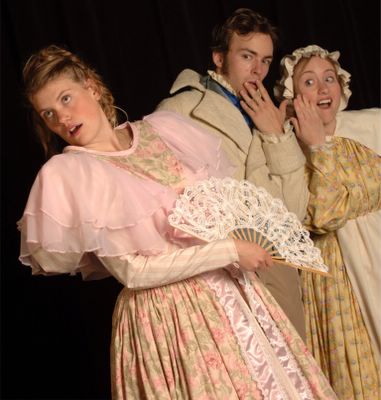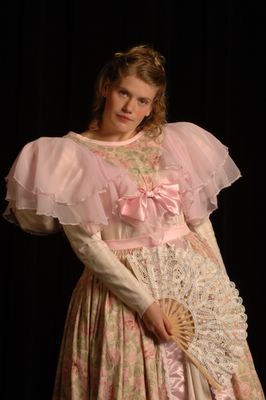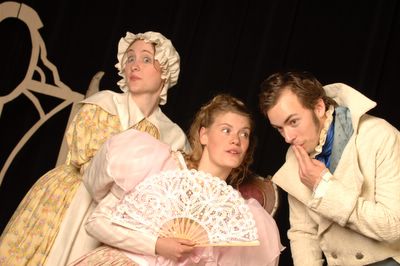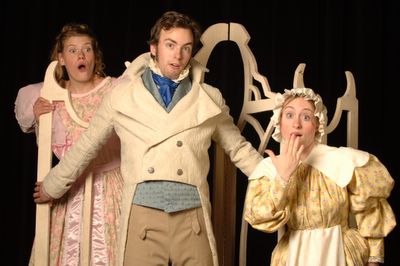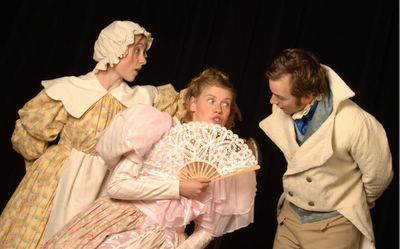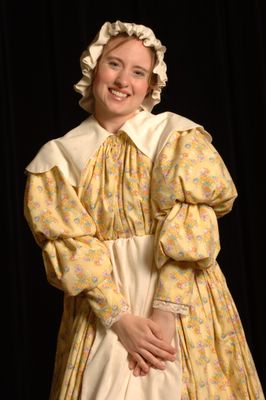The School for Scandal at HSU
THE SCHOOL FOR SCANDAL, , Sheridan’s comedy of gossip, wit and mayhem comes to the Humboldt State University Gist Hall stage on Thursday, Friday and Saturday nights at 7:30 PM, November 30-December 2, and December 7-9. $10 general, $8 students/seniors, limited free seats to HSU students. HSU ticket office: 826-3928. Directed by Clint Rebik; an HSU Department of Theatre, Film & Dance production.
Saturday, December 09, 2006
Thursday, December 07, 2006
Don't Miss It!
The School For Scandal is on the cover of Northern Lights, the weekly entertainment magazine of the Eureka Times-Standard. Under the headline HSU's 'School for Scandal' does everything right,' reviewer Betti Trauth writes: "I can truthfully say that I just love HSU's outrageous 'School for Scandal.' Don't miss it."
Find the full review here.
Wednesday, December 06, 2006
Behind the Scenes
The HSU student newspaper, the Lumberjack, visited the dressing rooms of The School for Scandal to produce a photo essay published in its December 6 issue. Nine photos by Steve Spain follow the frenetic process of costuming and makeup for a cast of 20. The two pages of color photos are not yet on line--but the newspaper is available on campus and in many other locations in Arcata all week.
Friday, December 01, 2006
Media Preview
Betti Trauth in the Eureka Times Standard previews the show, taking special note of the spectacular costumes designed by new HSU Dept. of Theatre, Film & Dance faculty member, Rae Robison--who also plays a key role in the cast (Dame Olivia Surface) and served as well as a period dialect and movement coach.
Trauth quotes Clint Rebik, director of The School for Scandal: “Pushing the era of the script's original 1700s setting forward to the 1820s made it possible to costume the actors in the more elaborate styles of that particular period. The resulting look of the show is spectacular -- you'd have to go to Ashland to the Oregon Shakespeare Festival to see anything comparable.”
He explained, “OSF is actually one of the few theater companies who stages such rarely seen plays as Sheridan's 'Scandal' -- because they're artistically and technically so challenging to mount. But, we've done it here at HSU; and I couldn't be prouder of what we've accomplished. It will be a real treat for the audience.”
The opening night audience could only agree. The School for Scandal continues at 7:30 PM on Friday and Saturday, December 1 & 2, and returns Thursday, Friday and Saturday, December 7, 8 and 9.
Thursday, November 30, 2006
THE SCHOOL FOR SCANDAL
Sheridan’s comedy of gossip, wit and mayhem comes to the Humboldt State University Gist Hall stage on Thursday, Friday and Saturday nights at 7:30 PM, November 30-December 2, and December 7-9. $10 general, $8 students/seniors, limited free seats to HSU students. HSU ticket office: 826-3928. Directed by Clint Rebik; an HSU Department of Theatre, Film & Dance production.
Monday, November 20, 2006
The November 7th elections made history, as control of Congress changed hands for the first time in 12 years and the President’s party was soundly defeated across the country, resulting in resignations by both the Secretary of Defense and the chairman of the Republican party. But of course, that wasn’t the big news of the day.
The big news was that Britney Spears announced she wanted a divorce.
In this respect, things haven’t changed a lot since the first performance of Richard Sheridan’s The School for Scandal in the late eighteenth century. Surrounded by war and revolution, the smart set of London still devoted considerable energy to gossip, tabloid journalism, and bedroom intrigue.
“It’s a classic comedy of the English stage, complete with fancy costumes, witty dialogue and physical comedy,” says Clint Rebik, director of the HSU production. “But it concerns a society wrapped up in gossip and the doings of other people, where social status and power depends on who controls what’s being said and how it’s being portrayed. We’re not hammering at the contemporary relevance in our production, but audiences aren’t going to have a problem seeing it.”
Colorful characters with names like Lady Teazle, Charles Surface, Sir Benjamin Backbite and Lady Sneerwell are outrageous gossips and victims of gossip, in a comic story filled with complications, ironies, surprises and schemes that go horribly wrong. This prototype of situation comedy also reveals many of the same guilty pleasures and petty obsessions we know today.
It begins as several characters discuss the contents of their tabloid equivalent of the National Enquirer. And it includes a familiar sort of hypocrisy, as characters deplore the salacious gossip they are spreading in the act of condemning it.
They engage in the kind of gossip we call dish. It’s served in heaping portions in The School for Scandal. There’s dish about women trying to look younger—though without the services of cosmetic surgery, they’re forced to rely on makeup, which also doesn’t fool anyone. When Lady Sneerwell criticizes the heavy paint a certain widow applies on her face to obscure her wrinkles, Sir Backbite “defends” the woman by saying, “’Tis not that she paints so ill—but, when she has finished her face, she joins it so badly to her neck, that she looks like a mended statue, in which the connoisseur may see at once that the head’s modern, but the trunk’s antique!”
There’s also plenty of dish about the elderly Sir Peter Teazle and his young, beautiful “trophy” wife, Lady Teazle.
There are also premonitions of other obsessions of today, as one character complains of the trendy replacement of wine with designer water: “Oh, certainly society suffers from it intolerably; for now, instead of the social spirit of raillery that used to mantel over a glass of bright Burgundy, their conversation is become just like the spa water they drink, which has all the pertness and flatulence of champagne without its spirit or flavor.”
The HSU production has moved the period slightly to the 1820s, to allow for more sumptuous and colorful costumes. “We’ve also gender-bent a couple of characters,” Rebik says, “which makes it more interesting when in the play one has to impersonate another character.”
“We have a cast of 20, many of whom are HSU theatre majors, but also actors from the community, and some doing theatre for the first time. For others, it’s a passion they’ve pursued for some time, outside their job or field of study.”
The School for Scandal has delighted audiences around the world for more than two centuries. Laurence Olivier, Vivian Leigh, Ralph Richardson and John Geilgud are a few of the famous actors who played it. (It was the first play in which Olivier and Leigh appeared together.) It remains a comic classic, with a combination of wit and slapstick, irony and farce—and with a few observations to make on how we live our lives, what we do versus what we say, and what true virtue might turn out to be.
The Story
The School For Scandal: The Story
The beautiful Lady Teazle is the elderly Sir Peter Teazle’s young trophy wife. Gossip abounds concerning her relationship with Charles Surface. Lady Sneerwell, leader of the social circle identified as “the school for scandal,” is spreading those rumors.
Why? Lady Sneerwell wants Charles for herself. But she knows Charles is in love with young Maria. She wants Maria to reject him for being unfaithful.
Charles has a brother, Joseph Surface. He actually is trying to seduce Lazy Teazle, though he, too, desires Maria. Joseph pretends to high virtue, but is a hypocrite. Charles lives the life of a libertine, but is generous and sincere.
Into this menagerie arrives a rich uncle (or in this production, an aunt) to the orphan Surface brothers, whose remains incognito to observe the brothers and decide which one deserves the family fortune.
Will Lady Teazle be ruined? Will Sir Teazle believe the rumors about her? Will Lady Sneerwell snare Charles, will Charles or Joseph end up with Maria, and/or their relative’s wealth? These questions are answered in farcical final scenes that involve a closet, a “duel,” a dressing screen, and a character named Snake who protests, “I live by the badness of my character; and if it were once known that I had been betrayed into an honest action, I should lose every friend I have in the world.”
Sunday, November 19, 2006
Our Production
Director----Clint Rebik
Script Editor----Tom Roscoe
Scenic Designer---Jody Segas
Lighting Designer----Katherine Bickford
Costume Designer----Rae Robison
Stage Manager----Justin Takata
Our Cast
Lady Sneerwell---- Leslie Hundley-Ostrom
Snake---- Charles Heinberg
Tick---- Karie Herbert
Joseph Surface---- David Abrams
Maria---- Megan Hughes
Mrs. Candour---- Missy Hopper
Mrs. Crabtree---- Megan Weckerly
Sir Backbite---- Jonny Barrett
Sir Peter Teazle---- John Michael Wilkerson
Rowley---- Dave D'Angelo
Lady Teazle---- Elisabeth Fairchild
Dame Surface---- Rae Robison
Principle---- Carter Howard
Trip---- Andrew Schnell
Charles Surface---- Ryan Hall
Careless ----Brenden O'Laughlin
Chug---- Alex Gradine
Guzzle---- Mason Lev
Sir Bumper---- Brian Pike
Flynch---- Mason Lev
The School For Scandal: Gossip From Its First Production
Richard Sheridan was not only the author of The School For Scandal, but the manager of the theatre where it was first produced, the Drury Lane in London. He was preceded in that job by one of the great theatrical innovators, David Garrick, who in the mid and late 18th century transformed the English stage into something more like the theatre we know today.
For example, he introduced new lighting, including footlights and sidelights. He re-designed the stage so dramas looked more naturalistic, with less opportunity for star actors to step to the apron for long soliloquies. He sought out the best stage designers of Europe, and recruited the best actors, rather than surrounding one star with no-talents. According to playwright and theatre historian Ronald Harwood, “Garrick was, in effect, the first real director that England had known.”
Garrick also introduced reforms affecting the audience. He created more distance between the stage and the front of the audience, where the gossips of the day used to spout their witticisms during the performance. Likewise he banned visitors from the backstage during the play, which all added to the atmosphere of hushed attention to only what’s happening on stage that theatergoers expect today.
Unfortunately, as a manager, Sheridan was no Garrick. He was extravagant, engaged in expensive lawsuits against other theatres, and drove away his best actors. Despite his own plays with their verbal wit, he tried to satisfy popular taste with spectacle. He even wrote one, a pantomime version of Robinson Crusoe.
Sheridan might have bankrupted the Drury Lane, except that in 1808 it burned to the ground. Nevertheless, Sheridan’s best plays-- The Rivals, The Critic and The School For Scandal—remain mainstays of the English repertoire. The Critic was a response to another innovation of Sheridan’s day—the rise of theatrical criticism, which grew in response to the “comedies of manners,” a category that includes The School For Scandal.
The School For Scandal: Gossip From Some Modern Productions
Probably the most famous modern production of The School For Scandal was the Old Vic version of the 1940s, if only because it was the first play that Laurence Olivier and Vivian Leigh did together in London. He played Sir Peter Teazle to her Lady Teazle.
They were the most glamorous theatrical couple in the world when they took The School For Scandal on a tour of Australia in 1948 in repertory with Richard III and Thorton Wilder’s The Skin of Our Teeth. Though Olivier and Leigh were treated like royalty, the tour was grueling and took a personal toll. “Somehow, somewhere on this tour I knew that Vivien was lost to me,” Olivier wrote many years later. While in Australia, Olivier also learned that he and Ralph Richardson had been deposed as directors of the Old Vic. To top even that, while doing a dance in The School For Scandal, Olivier’s knee gave out, and it required immediate surgery. A crane had to lift him in a stretcher to get him aboard the ship that took him home to England.
Probably the greatest modern triumph for The School For Scandal was with Olivier’s friend, Ralph Richardson, in the role of Teazle. His 1962 production at the London Haymarket was a long-running success. Towards the end of the run, John Gielgud joined the cast, playing Joseph Surface. The production toured the U.S., ending with a seven week run in New York. By then, Richardson and Gielgud had perfected the “screen scene” as a masterpiece of comic timing. Though they would act together many times through the years, this was one of their most brilliant successes.
